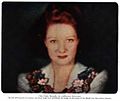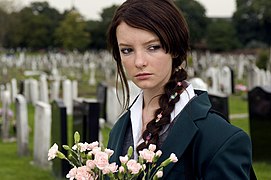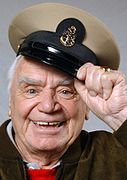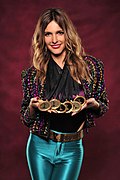Portal:Television
The Television Portal

Television (TV) is a telecommunication medium for transmitting moving images and sound. Additionally, the term can refer to a physical television set, rather than the medium of transmission. Television is a mass medium for advertising, entertainment, news, and sports. The medium is capable of more than "radio broadcasting", which refers to an audio signal sent to radio receivers.
Television became available in crude experimental forms in the 1920s, but only after several years of further development was the new technology marketed to consumers. After World War II, an improved form of black-and-white television broadcasting became popular in the United Kingdom and the United States, and television sets became commonplace in homes, businesses, and institutions. During the 1950s, television was the primary medium for influencing public opinion. In the mid-1960s, color broadcasting was introduced in the U.S. and most other developed countries.
In 2013, 79% of the world's households owned a television set. The replacement of earlier cathode-ray tube (CRT) screen displays with compact, energy-efficient, flat-panel alternative technologies such as LCDs (both fluorescent-backlit and LED), OLED displays, and plasma displays was a hardware revolution that began with computer monitors in the late 1990s. Most television sets sold in the 2000s were flat-panel, mainly LEDs. Major manufacturers announced the discontinuation of CRT, Digital Light Processing (DLP), plasma, and even fluorescent-backlit LCDs by the mid-2010s. LEDs are being gradually replaced by OLEDs. Also, major manufacturers have started increasingly producing smart TVs in the mid-2010s. Smart TVs with integrated Internet and Web 2.0 functions became the dominant form of television by the late 2010s. (Full article...)
Selected article -
Carnivàle (/ˌkɑːrnɪˈvæl/) is an American television series set in the United States Dust Bowl during the Great Depression of the 1930s. The series, created by Daniel Knauf, ran for two seasons between 2003 and 2005. In tracing the lives of disparate groups of people in a traveling carnival, Knauf's story combined a bleak atmosphere with elements of the surreal in portraying struggles between good and evil and between free will and destiny. The show's mythology draws upon themes and motifs from traditional Christianity and gnosticism together with Masonic lore, particularly that of the Knights Templar order.
Carnivàle was produced by HBO and aired between September 14, 2003, and March 27, 2005. Its creator, Daniel Knauf, also served as executive producer along with Ronald D. Moore and Howard Klein. Jeff Beal composed the original incidental music. Nick Stahl and Clancy Brown starred as Ben Hawkins and Brother Justin Crowe, respectively. The show was filmed in Santa Clarita, California, and nearby Southern California locations.
Selected image -

Fuji Television Network, Inc. Kabushiki Gaisha Fuji Terebijon is a Japanese television network based in Odaiba, Minato-ku, Tokyo, Japan. It is known as Fuji TV Fuji Terebi or CX. It is the flagship TV station of Fuji News Network (FNN) and Fuji Network System or FNS. It also has a relationship with Nippon Broadcasting System, Inc.
Did you know (auto-generated) -

- ... that Ruslana Pysanka, who hosted a Ukrainian television program with Volodymyr Zelenskyy, died as a refugee in Germany?
- ... that the European version of the video game Tomba! uses the theme song of the television series No Sweat as its opening theme?
- ... that the exclusive secret society Hamilton House from the television show Gossip Girl was based on St. Anthony Hall, a social and literary fraternity?
- ... that Singaporean singer Dawn Gan played herself in a television drama about aspiring singers?
- ... that reporter Bobbie Wygant got her first television show after filling in while its host was sick with the flu?
- ... that actor Tatsunari Kimura ate pancakes and drank coffee while talking for eight hours during the filming of the television drama Old-Fashioned Cupcake?
Selected quote -
More did you know
- ...that The Simpsons and Philosophy: The D'oh! of Homer, a book that analyzes the The Simpsons using philosophical concepts, is the main textbook in philosophy courses offered at some universities?
- ...that the 1994 Guinness television advertisement Anticipation used jump cutting techniques to make an actor appear to be performing a physically impossible dance?
- ...that model Albert Reed, selected to appear in September 2007 on the United States television show Dancing with the Stars, admits that he cannot dance?
- ...that the final episode of the 1986 television series Outlaws recycled footage from The Oregon Trail, because actors Rod Taylor and Charles Napier appeared in both programs?
- ...that Russian television implied that Filipp Kirkorov won the Eurovision Song Contest 1995 with "Kolibelnaya Dlya Vulkana" when he in fact only came 17th?
Selected biography -
General images
The original "Treehouse of Horror" episode aired on October 25, 1990, and was inspired by EC Comics Horror tales. From "Treehouse of Horror" (1990) to "X" (1999), every episode has aired in the week preceding or on October 31; "II" and "X" are both the only episodes to air on Halloween. Between "XI" (2000) to "XIX" (2008) and "XXI" (2010), due to Fox's contract with Major League Baseball's World Series, episodes had originally aired in November. "XX" (2009) and each Treehouse of Horror episode since "XXII" (2011) has aired in October, with the exception of season thirty two's "XXXI" (2020), which was originally scheduled for October 18, but was postponed to November 1 due to the 2020 NLCS reaching game 7. This was the first time since "XXI" that a Treehouse of Horror episode aired in November. The same thing happened with season thirty-five's "XXXIV" (2023), which aired on November 5. (Full article...)
Black Mirror is a British science fiction anthology series created by Charlie Brooker. From 2011 to 2013, the first two series aired on British network Channel 4, as did the special "White Christmas" (2014); the following four series were released on the American streaming platform Netflix from 2016 to 2023. There are twenty-seven episodes in the show's first six series, and an additional interactive film Bandersnatch (2019). Inspired by The Twilight Zone, each episode of Black Mirror is standalone and explores the common theme of technology and its side-effects.
Black Mirror has received positive reception from critics and has been nominated for ninety-nine awards, winning twenty-seven of them. The most acclaimed episodes are "USS Callister", which won four Emmy Awards, and "San Junipero", which won two. Additionally, the interactive film Black Mirror: Bandersnatch won two Emmy Awards. As actors rarely appear in more than one episode, the only people to receive multiple awards for their work on the show are writer Charlie Brooker, who has won seven, and executive producer Annabel Jones, who has won four. The series has been nominated for seventeen British Academy Film Awards, winning two, and fifteen Emmy Awards, winning nine. (Full article...)

In addition to the show's regular cast of voice actors, guest stars have been featured on SpongeBob SquarePants, an American animated television series created by marine biologist and animator Stephen Hillenburg for Nickelodeon. SpongeBob SquarePants chronicles the adventures and endeavors of the title character and his various friends in the fictional underwater city of Bikini Bottom. Many of the ideas for the show originated in an unpublished, educational comic book titled The Intertidal Zone, which Hillenburg created in the mid-1980s. He began developing SpongeBob SquarePants into a television series in 1996 upon the cancellation of Rocko's Modern Life, which Hillenburg directed. The pilot episode first aired on Nickelodeon in the United States on May 1, 1999. The show's thirteenth and current season premiered in 2020, and 276 episodes of SpongeBob SquarePants have aired. A series of theatrical films based on the show began in 2004 with The SpongeBob SquarePants Movie.
Guest voices have come from many ranges of professions, including actors, athletes, authors, musicians, and artists. The first credited guest stars were McHale's Navy actors Ernest Borgnine and Tim Conway, who appeared in "Mermaid Man and Barnacle Boy (I)", the show's sixth episode. Borgnine and Conway have since been featured as recurring characters on the show until 2012. Rock band Ghastly Ones were the first guest stars to appear as themselves, appearing for a special musical performance in the first-season episode "Scaredy Pants". Aside from the aforementioned actors, actress Marion Ross has a recurring role as Grandma SquarePants, SpongeBob's grandmother. Borgnine has made the most appearances, guest starring 16 times. Conway has made 15 guest appearances, while Ross has appeared four times, John O'Hurley appeared three times, and John Rhys-Davies has appeared twice. Michael McKean has also appeared twice, voicing different characters. (Full article...)
| Season | Episodes | Originally aired | Average viewers (millions) | Rank | ||
|---|---|---|---|---|---|---|
| First aired | Last aired | |||||
| 1 | 24 | September 10, 1993 | May 13, 1994 | 11.21 | 111 | |
| 2 | 25 | September 16, 1994 | May 19, 1995 | 14.50 | 63 | |
| 3 | 24 | September 22, 1995 | May 17, 1996 | 15.40 | 55 | |
| 4 | 24 | October 4, 1996 | May 18, 1997 | 19.20 | 20 | |
| 5 | 20 | November 2, 1997 | May 17, 1998 | 19.80 | 11 | |
| The X-Files | June 19, 1998 | — | — | |||
| 6 | 22 | November 8, 1998 | May 16, 1999 | 17.20 | 12 | |
| 7 | 22 | November 7, 1999 | May 21, 2000 | 14.20 | 29 | |
| 8 | 21 | November 5, 2000 | May 20, 2001 | 13.93 | 31 | |
| 9 | 20 | November 11, 2001 | May 19, 2002 | 9.10 | 63 | |
| I Want to Believe | July 25, 2008 | — | — | |||
| 10 | 6 | January 24, 2016 | February 22, 2016 | 9.54 | 7 | |
| 11 | 10 | January 3, 2018 | March 21, 2018 | 5.34 | 91 | |

Game of Thrones is an American fantasy drama television series created by David Benioff and D. B. Weiss. The series is based on George R. R. Martin's series of fantasy novels, A Song of Ice and Fire. The series takes place on the fictional continents of Westeros and Essos, and chronicles the power struggles among noble families as they fight for control of the Iron Throne of the Seven Kingdoms. The series starts when House Stark, led by Lord Eddard "Ned" Stark (Sean Bean), is drawn into schemes surrounding King Robert Baratheon (Mark Addy).
The series premiered on April 17, 2011, on HBO. David Benioff and D. B. Weiss both serve as executive producers, along with Carolyn Strauss, Frank Doelger, Bernadette Caulfield, and George R. R. Martin. Filming for the series took place in a number of locations, including Croatia, Northern Ireland, Iceland, and Spain. Episodes were broadcast on Sunday at 9:00 pm Eastern Time, and the episodes are between 50 and 82 minutes in length. All eight seasons are available on DVD, Blu-ray and Ultra HD Blu-ray. (Full article...)

The Scottish actor Alastair Sim (1900–1976) performed in many media of light entertainment, including theatre, film and television. His career spanned from 1930 until his death. During that time he was a "memorable character player of faded Anglo-Scottish gentility, whimsically put-upon countenance, and sepulchral, sometimes minatory, laugh".
After studying chemistry at the University of Edinburgh, he was employed, between 1925 and 1930, as a lecturer in elocution at New College, Edinburgh, and also established his own school of drama and speech training. In 1930 he made his professional stage debut as a messenger in Othello at the Savoy Theatre, London—with Paul Robeson and Peggy Ashcroft in the lead roles. During the next five years he appeared on stage in New York and the UK, and spent two years at the Old Vic. (Full article...)
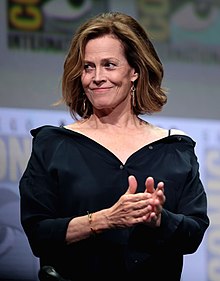
Sigourney Weaver is an American actress who began her career in the early 1970s by appearing in plays. Throughout her career, she has acted in nearly 40 stage productions. She made her film debut with a minor role in Woody Allen's comedy-drama Annie Hall (1977), but her breakthrough came when she portrayed Ellen Ripley in Ridley Scott's science fiction film Alien (1979). She reprised the role in Aliens (1986), this time helmed by director James Cameron. Her performance netted her a nomination for the Academy Award for Best Actress. She returned to the role in two more sequels: Alien 3 (1992) and Alien Resurrection (1997), neither of which were as well received. Although originally written as a male role, Ripley is now regarded as one of the most significant female protagonists in cinema history, and consequently, Weaver is considered to be a pioneer of action heroines in science fiction films.
Although best known for her role in the Alien franchise, Weaver has fostered a prolific filmography, appearing in more than 60 films. In 1981, she starred alongside William Hurt in the neo-noir Eyewitness. Her next role was opposite Mel Gibson in the Peter Weir–directed The Year of Living Dangerously (1982). She played Dana Barrett in Ghostbusters (1984), later returning to the franchise in Ghostbusters II (1989), Ghostbusters (2016), and Ghostbusters: Afterlife (2021). In 1986, Weaver starred opposite Michael Caine in the erotic thriller Half Moon Street. Her next role was primatologist Dian Fossey in Gorillas in the Mist (1988), for which she won a Golden Globe Award for Best Actress in a Motion Picture – Drama. That same year, she also won the Golden Globe Award for Best Supporting Actress – Motion Picture for her performance alongside Harrison Ford in Working Girl. Weaver was the first actor to have two acting wins at the Golden Globes in the same year. She also received an Academy Award nomination for both films. (Full article...)
In the first three series of the four-series programme, five major groups of meerkats were regularly shown, however, its primary focus was on a group called the Whiskers, one of the largest and oldest of the research groups. Other groups featured were neighbouring rival groups of the Whiskers and groups formed by former Whiskers members. During the first series, a group called the Lazuli were depicted as the Whiskers' main rivals, with occasional appearances by the smaller Gattaca group. In the second series, the Commandoes were introduced as one of the toughest rivals the Whiskers had ever faced, and by the third, the Commandoes had forced the Whiskers to move. The Whiskers then acquired two new neighbouring groups, the Zappa, with whom they had frequent confrontations, and the short-lived Starsky group formed by a trio of evicted Whiskers females. In the fourth and final series, one of the Whiskers' females formed a new group, the Aztecs. (Full article...)
News
- December 28: US professional wrestler Jon Huber dies aged 41
- September 2: Tributes paid to recently deceased US actor Chadwick Boseman
- May 24: Japanese professional wrestler and Netflix star Hana Kimura dies aged 22
- January 16: BBC newsreader Alagiah to undergo treatment for bowel cancer
- Upcoming events
Featured content
Main topics
History of television: Early television stations • Geographical usage of television • Golden Age of Television • List of experimental television stations • List of years in television • Mechanical television • Social aspects of television • Television systems before 1940 • Timeline of the introduction of television in countries • Timeline of the introduction of color television in countries
Inventors and pioneers: John Logie Baird • Alan Blumlein • Walter Bruch • Alan Archibald Campbell-Swinton • Allen B. DuMont • Philo Taylor Farnsworth • Charles Francis Jenkins • Boris Grabovsky • Paul Gottlieb Nipkow • Constantin Perskyi • Boris Rosing • David Sarnoff • Kálmán Tihanyi • Vladimir Zworykin
Technology: Comparison of display technology • Digital television • Liquid crystal display television • Large-screen television technology • Technology of television
Terms: Broadcast television systems • Composite monitor • HDTV • Liquid crystal display television • PAL • Picture-in-picture • Pay-per-view • Plasma display • NICAM • NTSC • SECAM
Categories
WikiProjects

|
You are invited to participate in WikiProject Television, a WikiProject dedicated to developing and improving articles about Television. |
- Main projects
- Sub-projects
Television Stations • American animation • American television • Australian television • British TV • BBC • Canadian TV shows • Television Game Shows • ITC Entertainment Productions • Digimon • Buffyverse • Doctor Who • Degrassi • EastEnders • Episode coverage • Firefly • Futurama • Grey's Anatomy • Indian television • Lost • Nickelodeon • The O.C. • Professional Wrestling • Reality TV • The Simpsons • Seinfeld • South Park • Stargate • Star Trek • Star Wars • Soap operas • Avatar: The Last Airbender • House
- Related projects
Animation • Anime and manga • Comedy • Comics • Fictional characters • Film • Media franchises
What are WikiProjects?
Things you can do

- Place the {{WikiProject Television}} project banner on the talk pages of all articles within the scope of the project.
- Write: Possible Possum
- Cleanup: color television, Alien Nation: Body and Soul, The Sopranos, Alien Nation: Dark Horizon, Alien Nation: The Enemy Within, Alien Nation: Millennium, Aang
- Expand: Timeline of the introduction of color television in countries
- Stubs: Flow (television), Just for Kicks (TV series), Play of the Month, Nova (Dutch TV series), More stubs...
Subportals
Related portals
Associated Wikimedia
The following Wikimedia Foundation sister projects provide more on this subject:
-
Commons
Free media repository -
Wikibooks
Free textbooks and manuals -
Wikidata
Free knowledge base -
Wikinews
Free-content news -
Wikiquote
Collection of quotations -
Wikisource
Free-content library -
Wikiversity
Free learning tools -
Wiktionary
Dictionary and thesaurus







